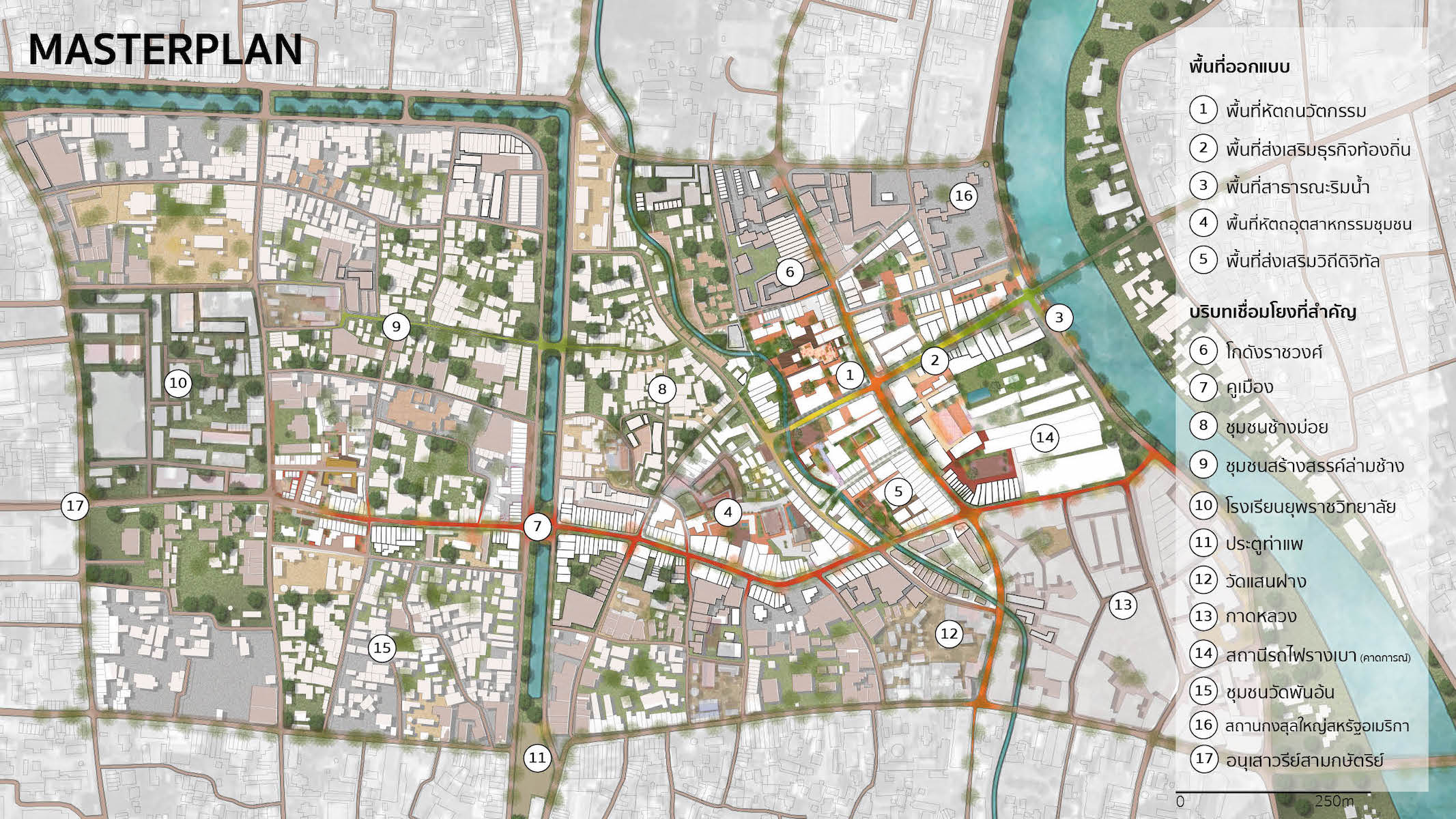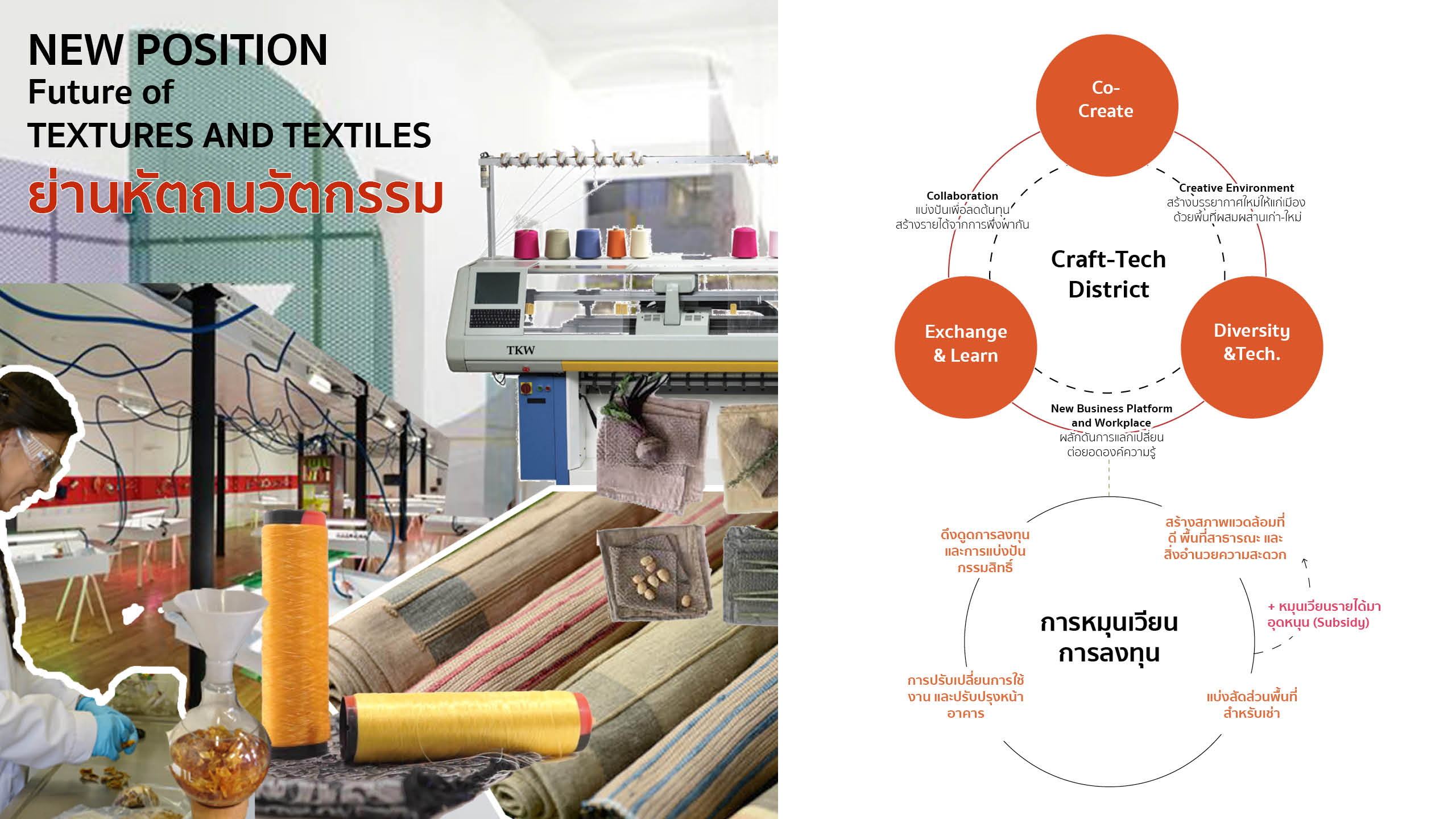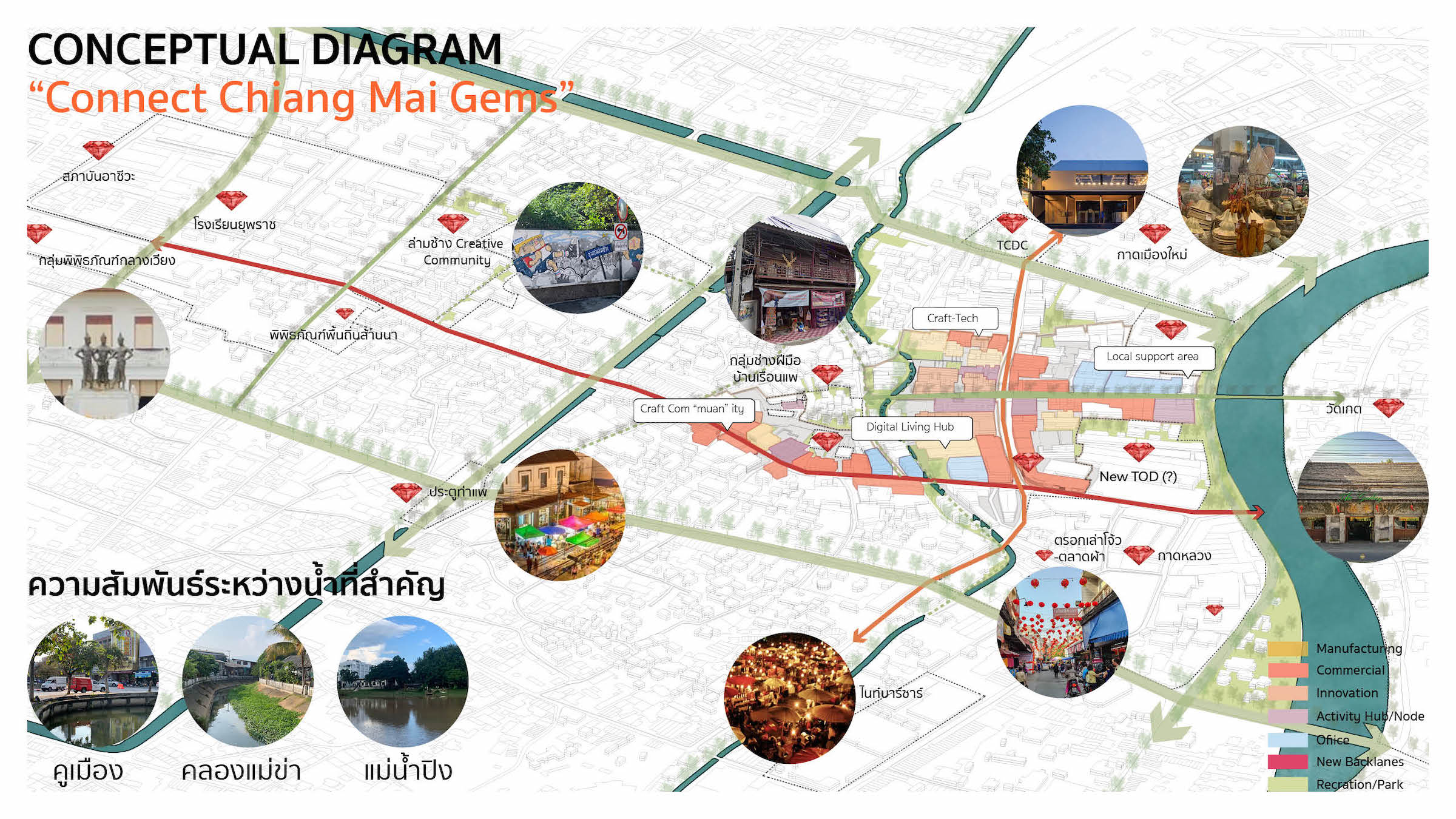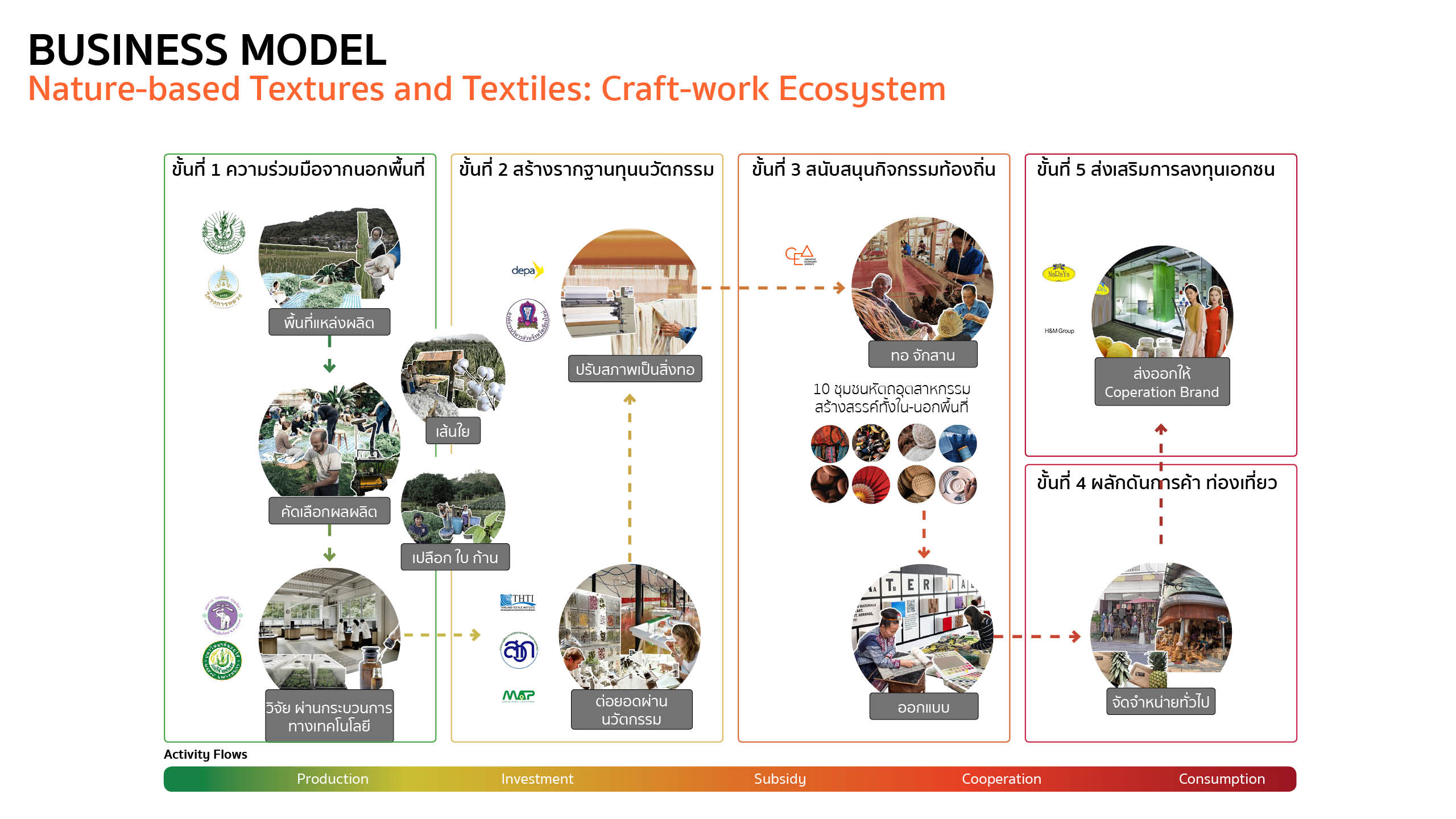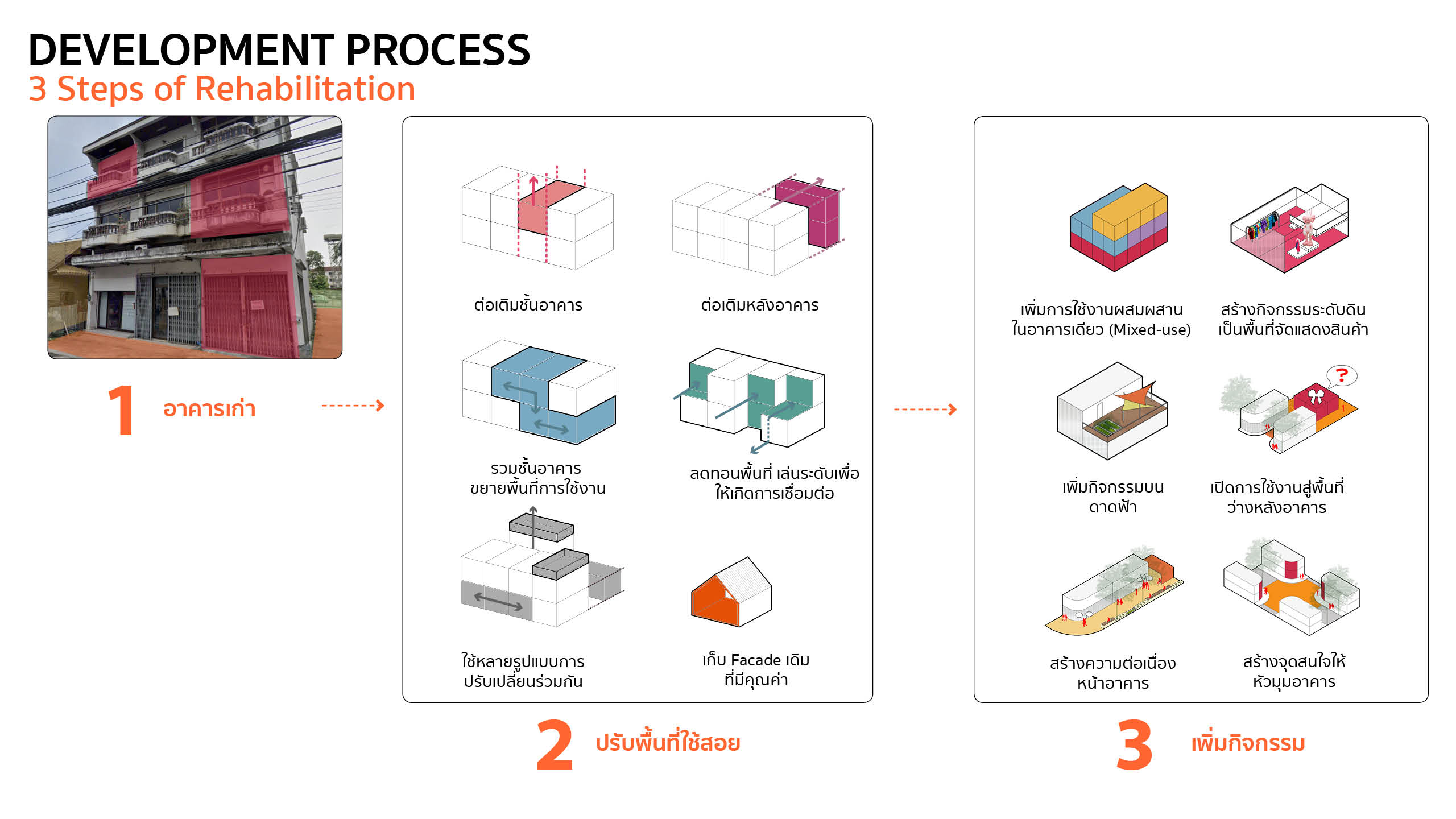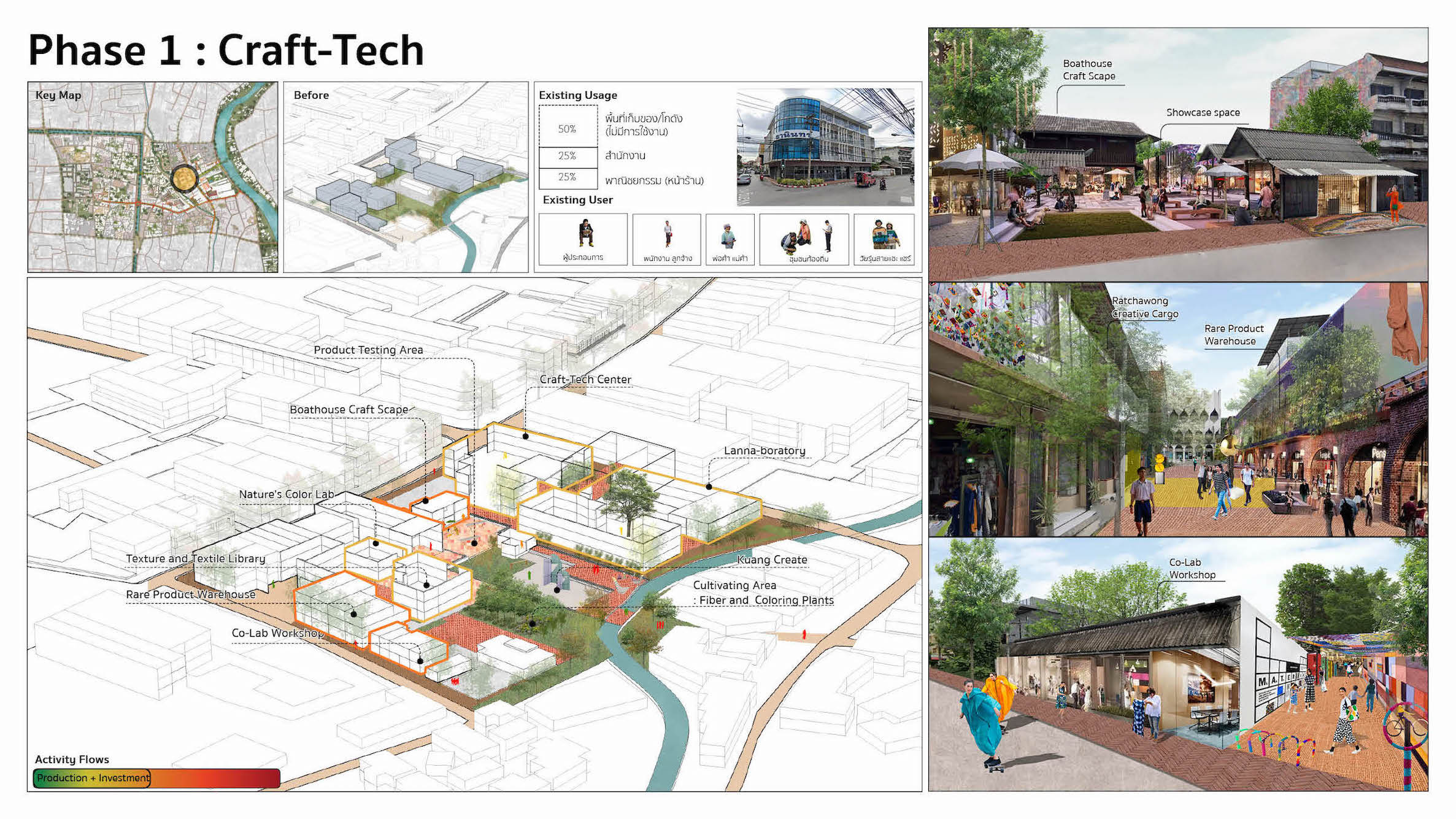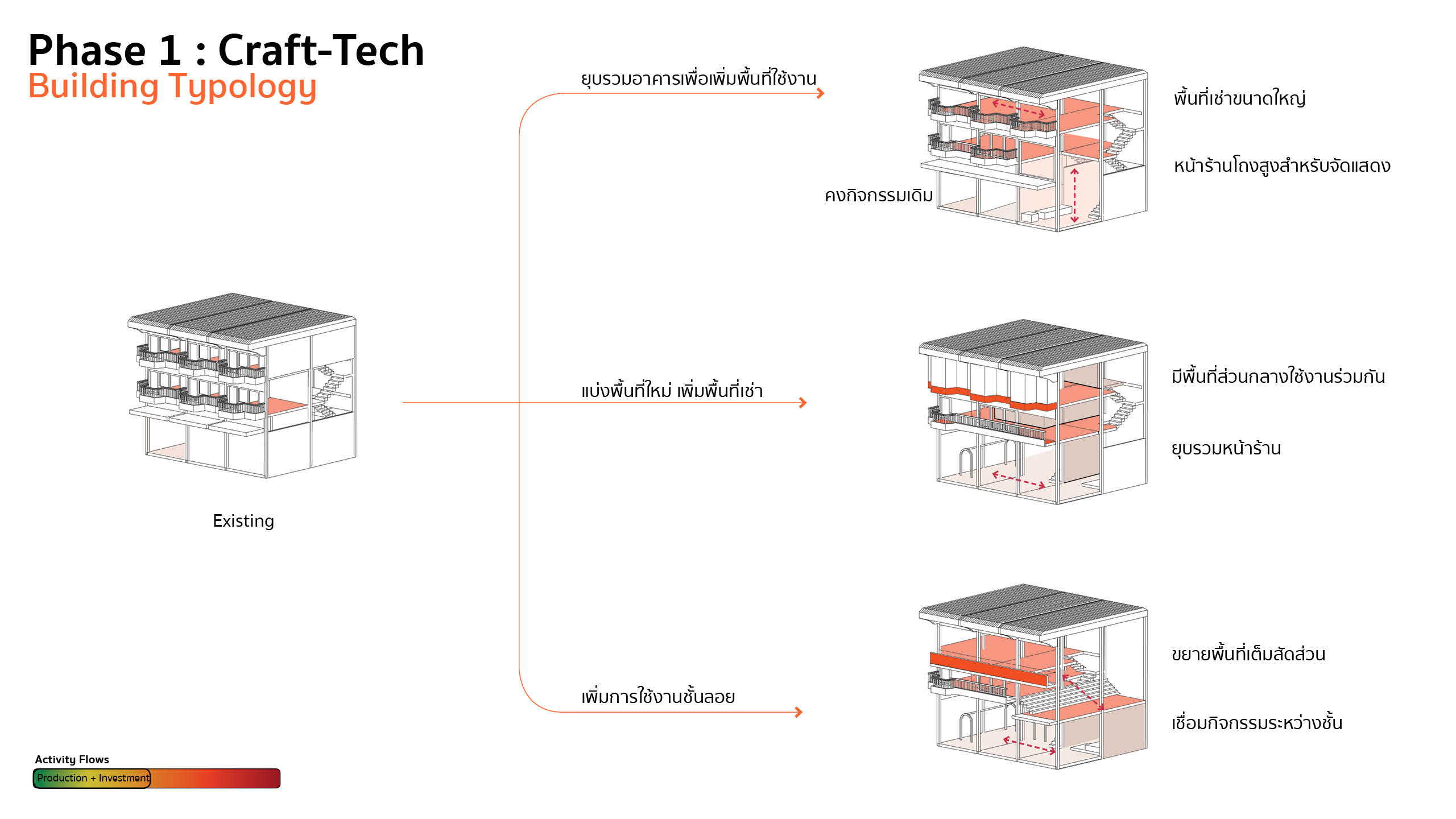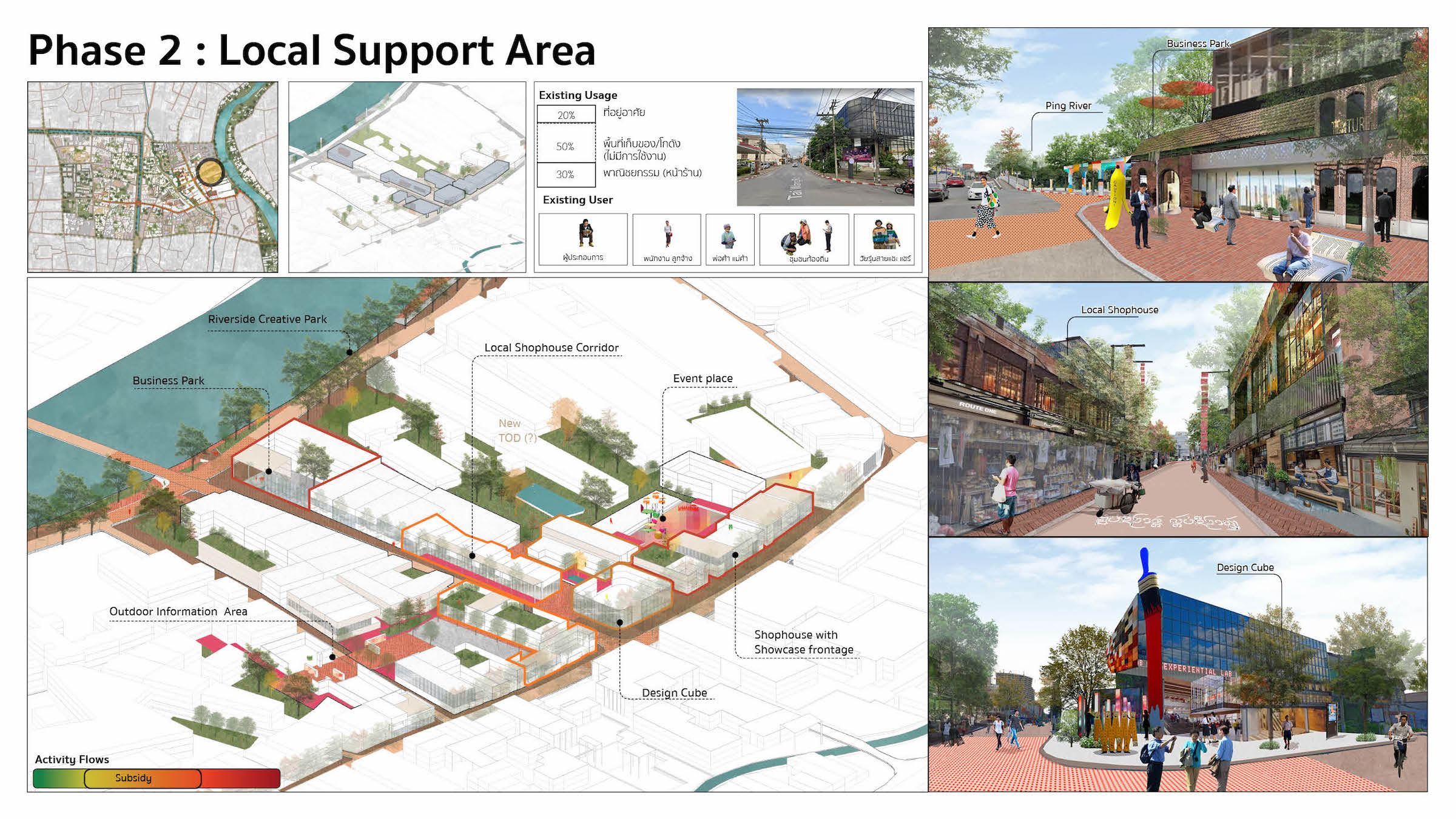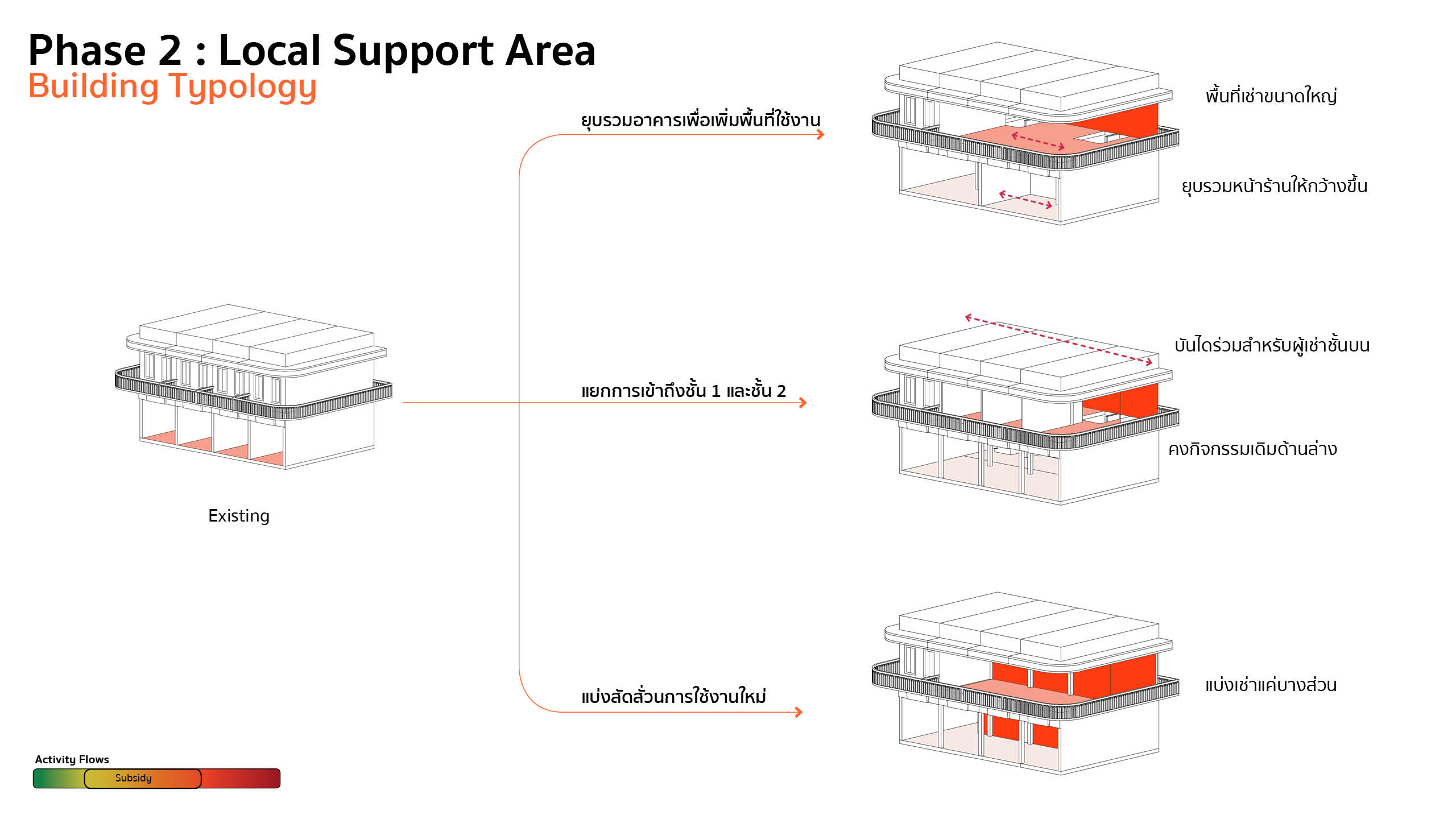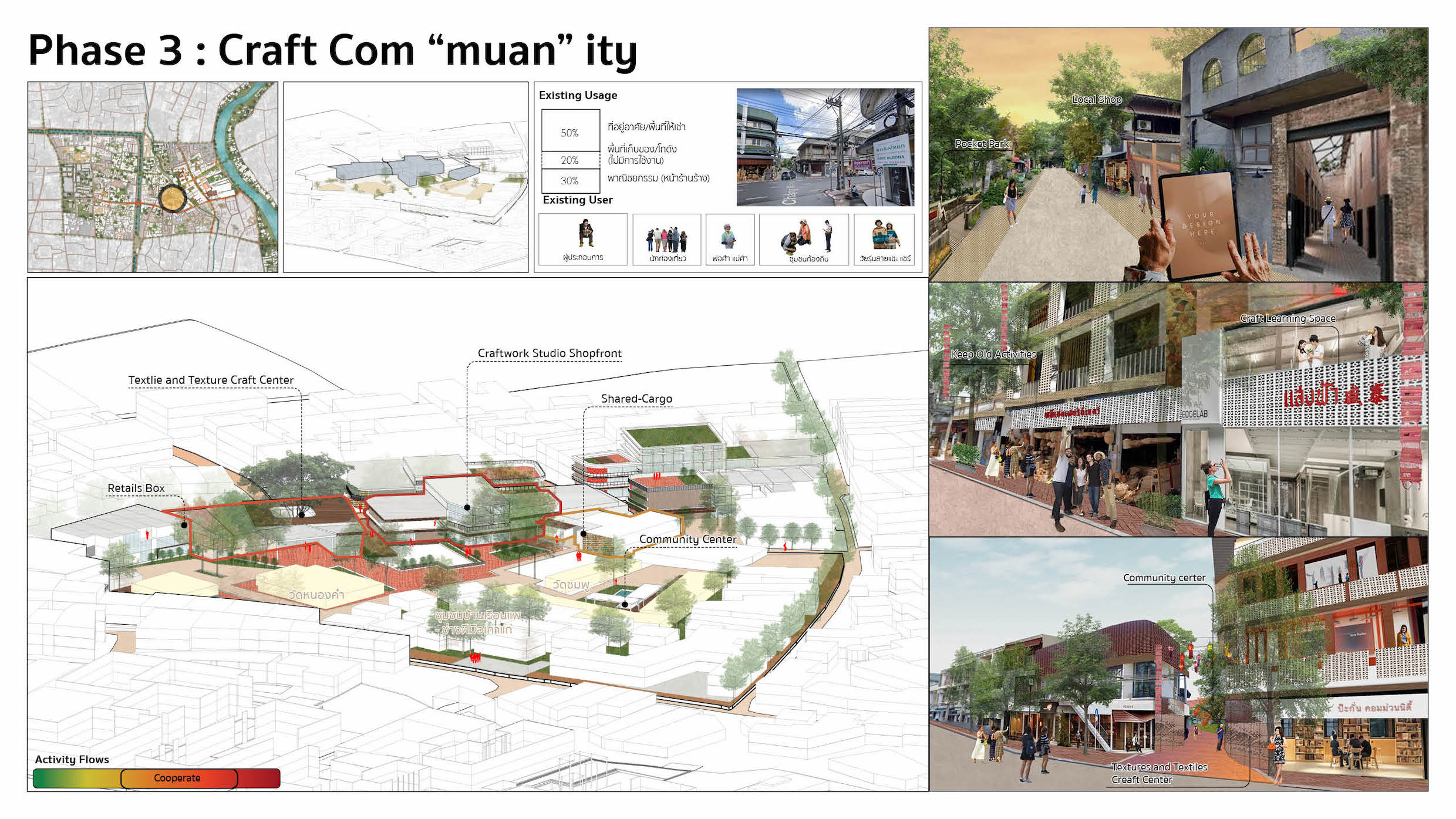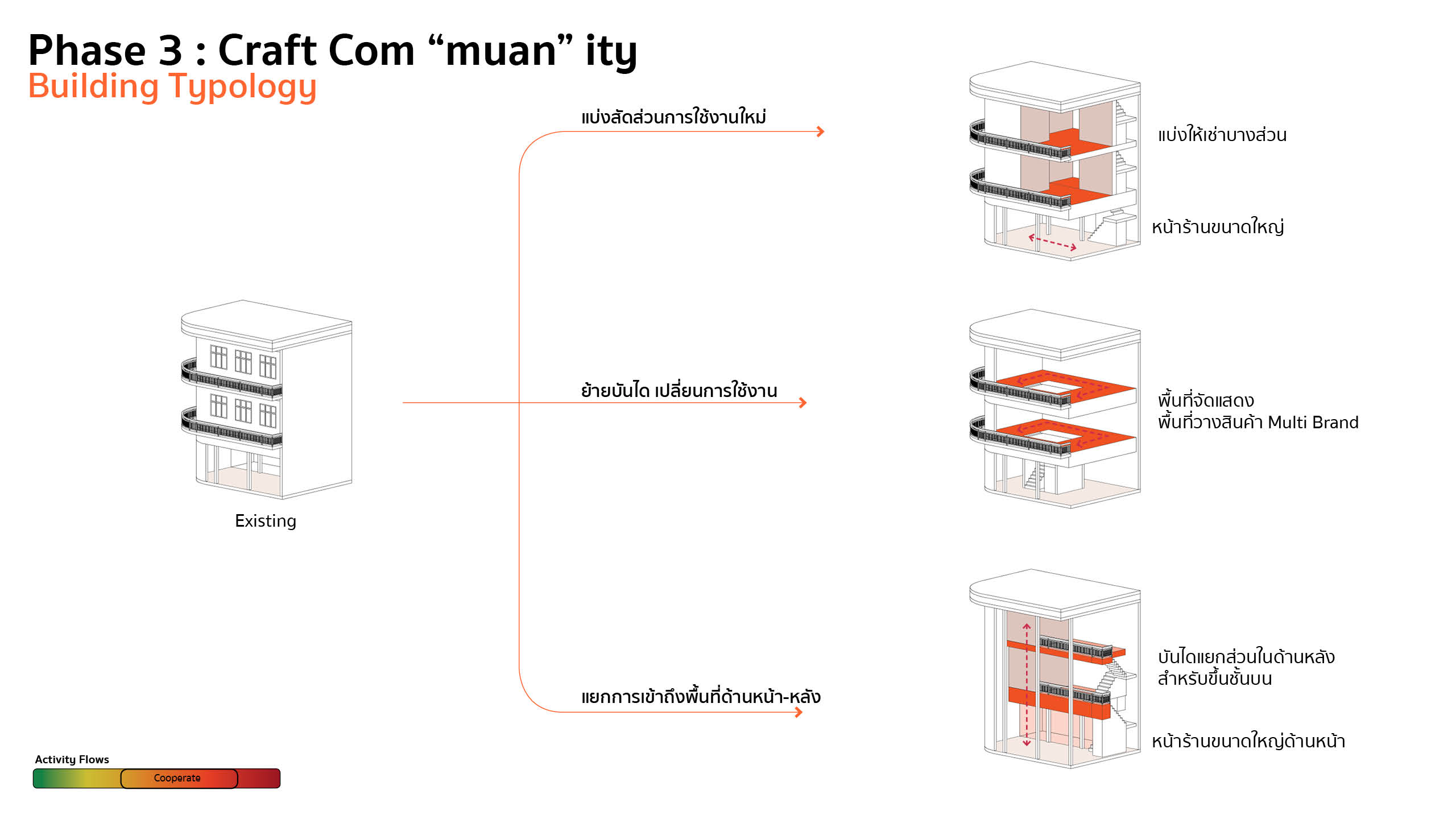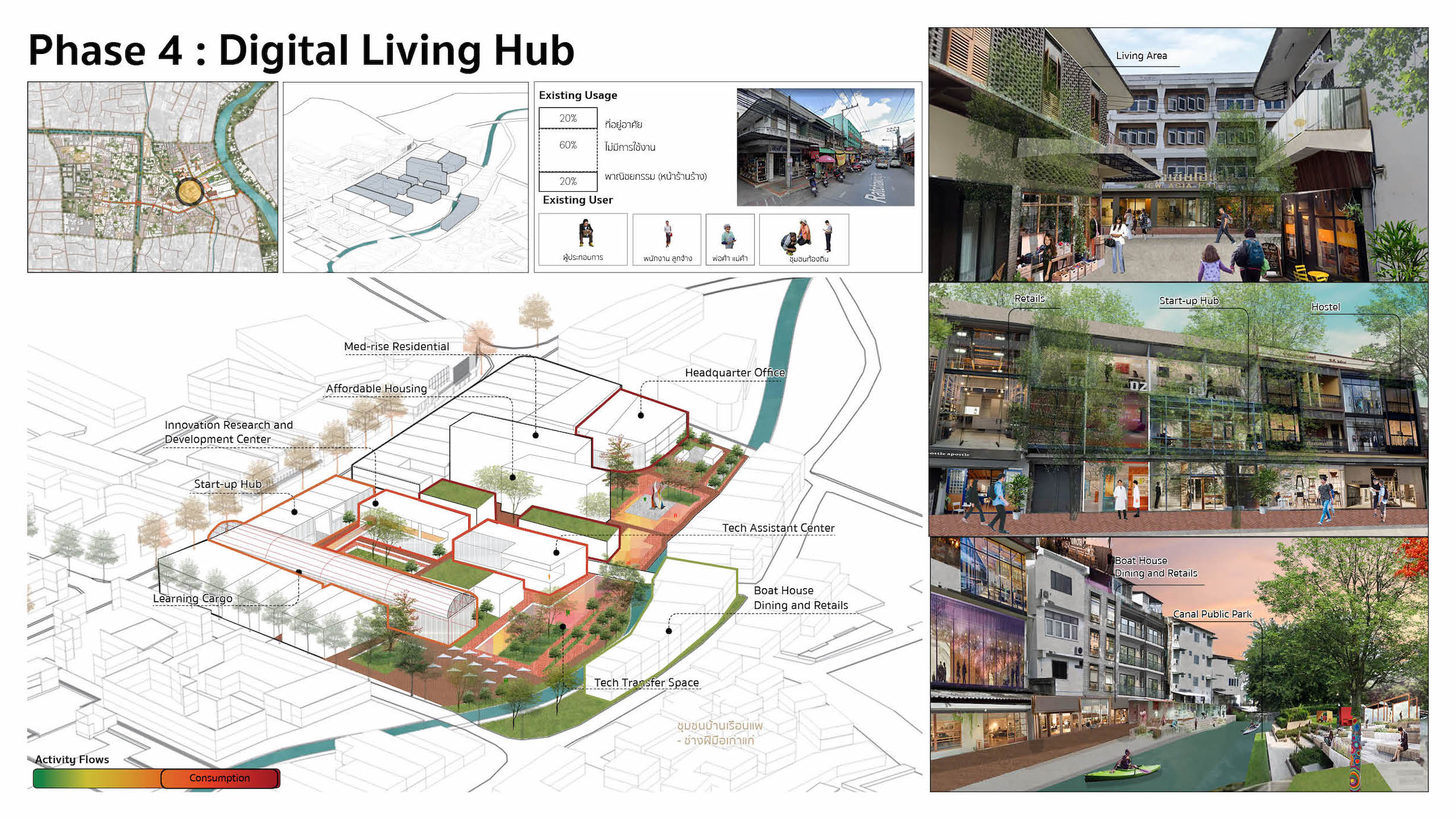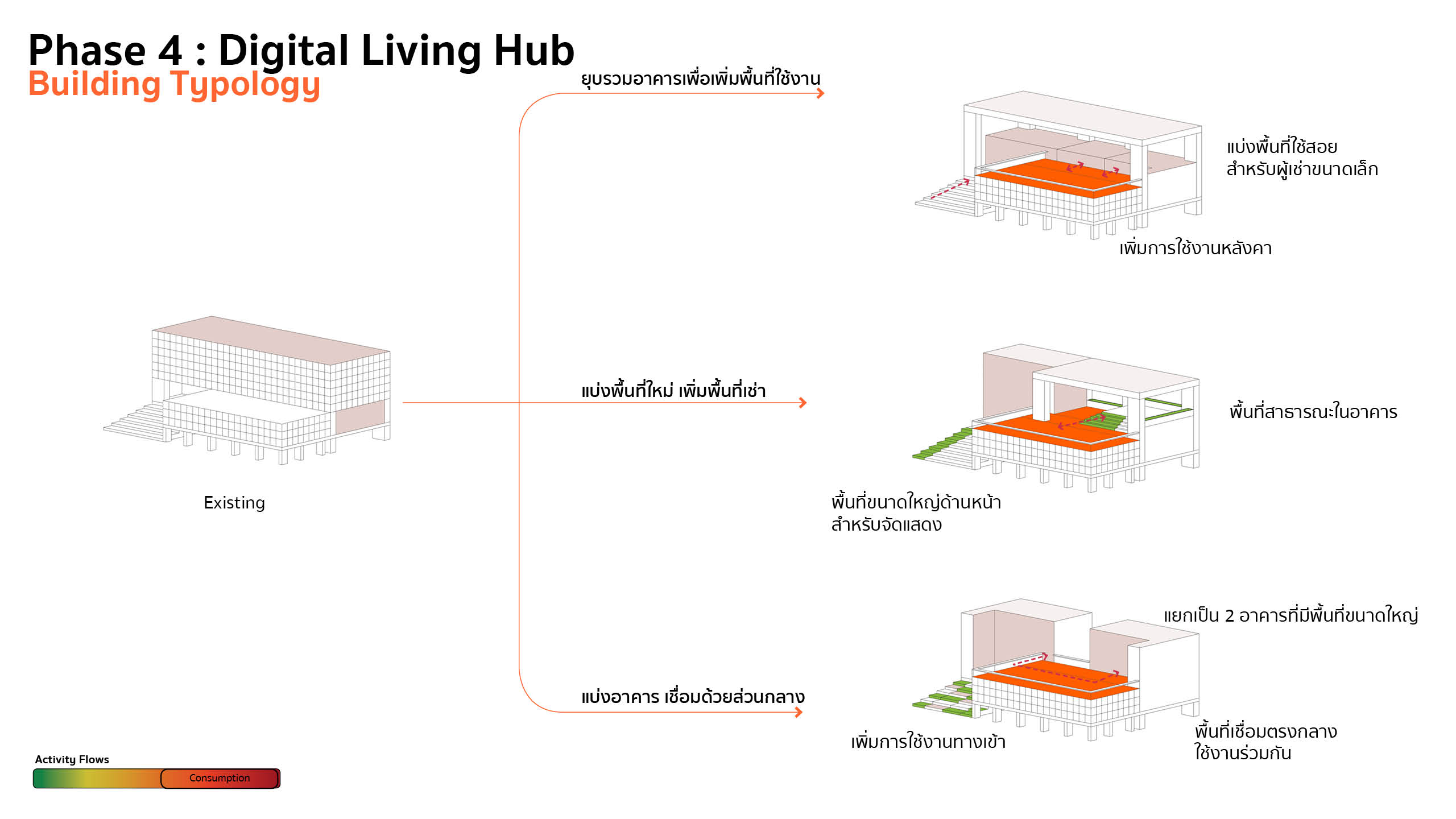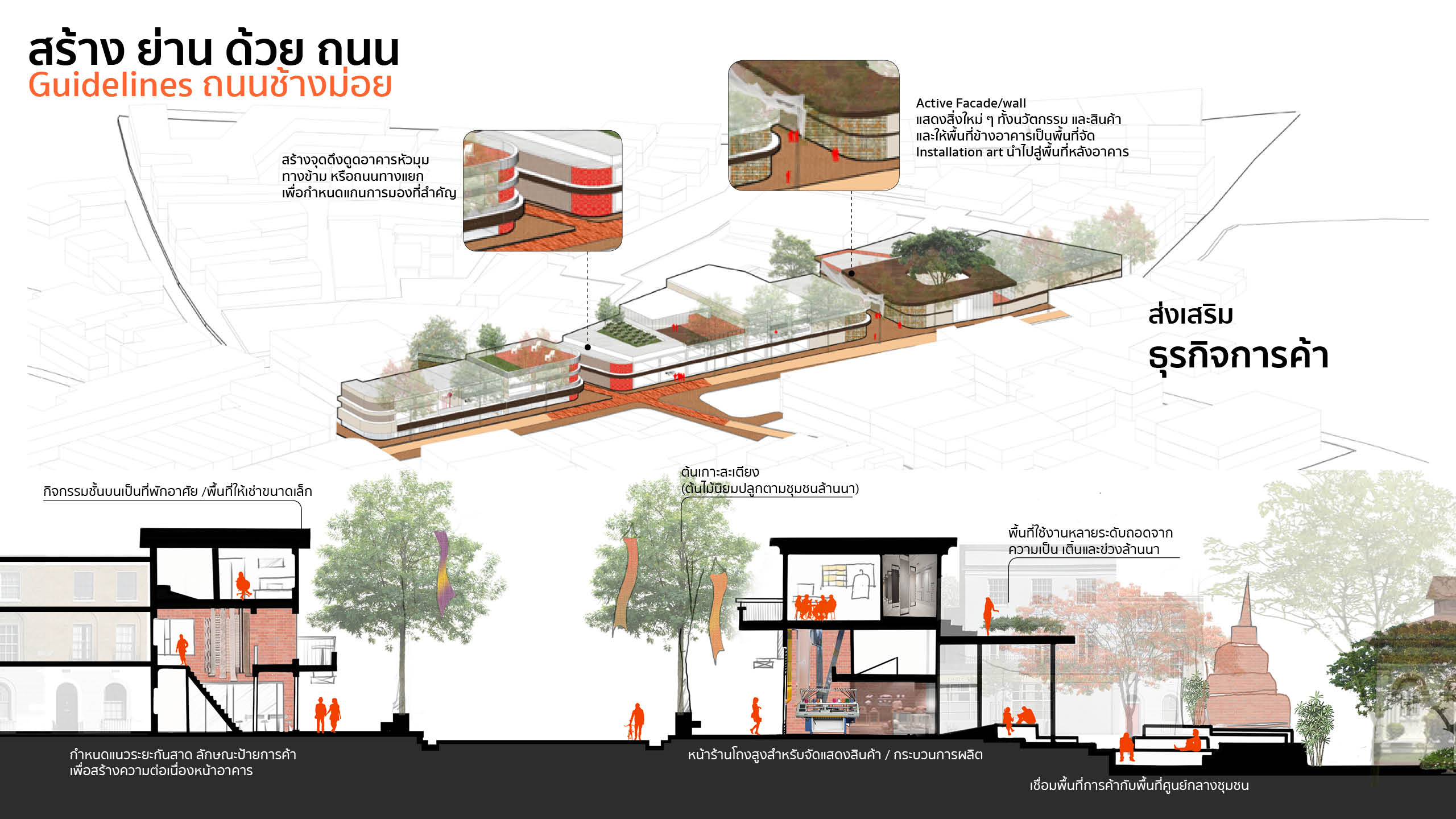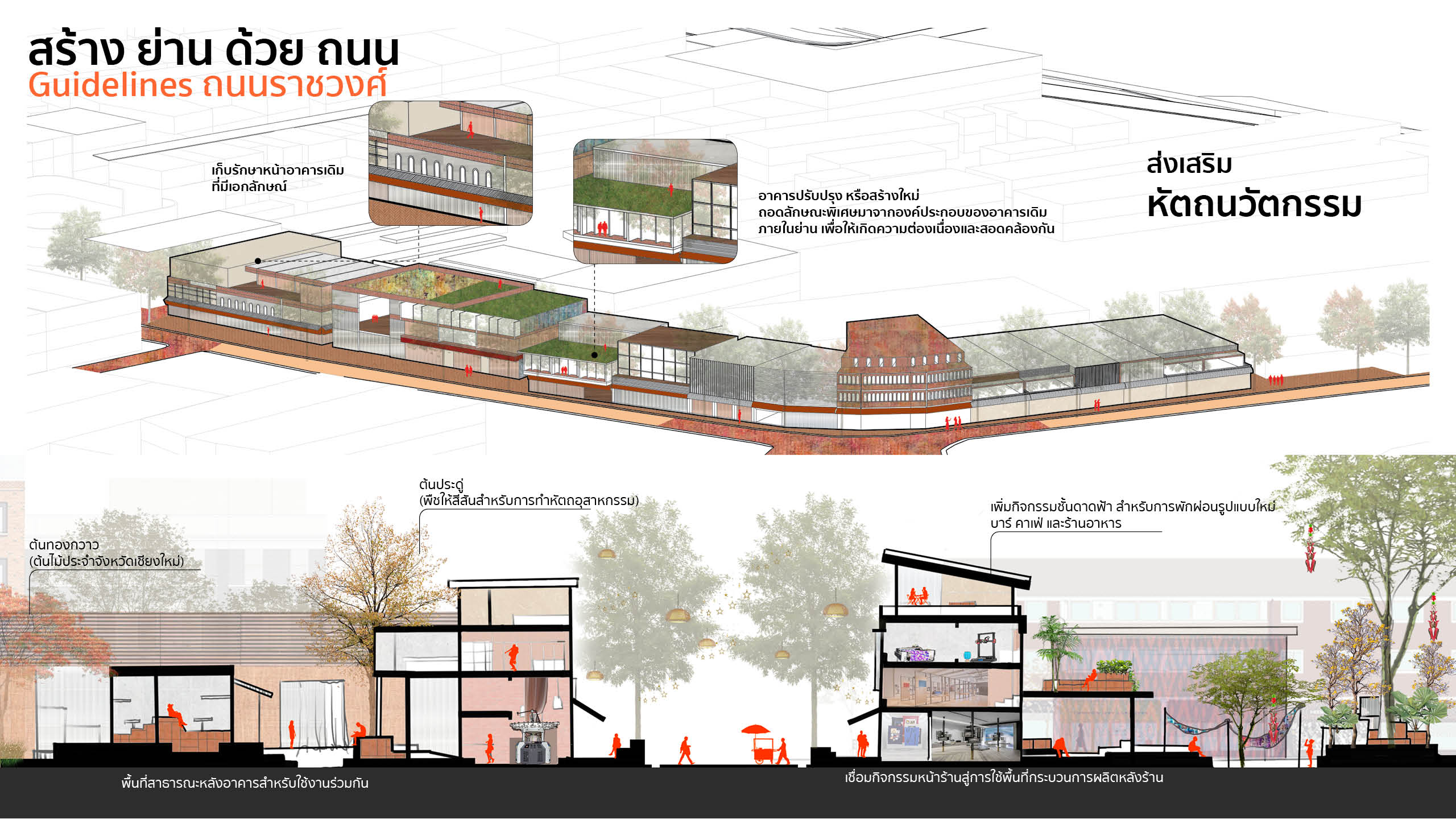โครงการพัฒนาย่านหัตถนวัตกรรมในพื้นที่เมืองเก่าเชียงใหม่
Chiang Mai Craft-Tech District
กัญชุดา เพ็ญไชยา
วิทยานิพนธ์ดีเด่น 2563
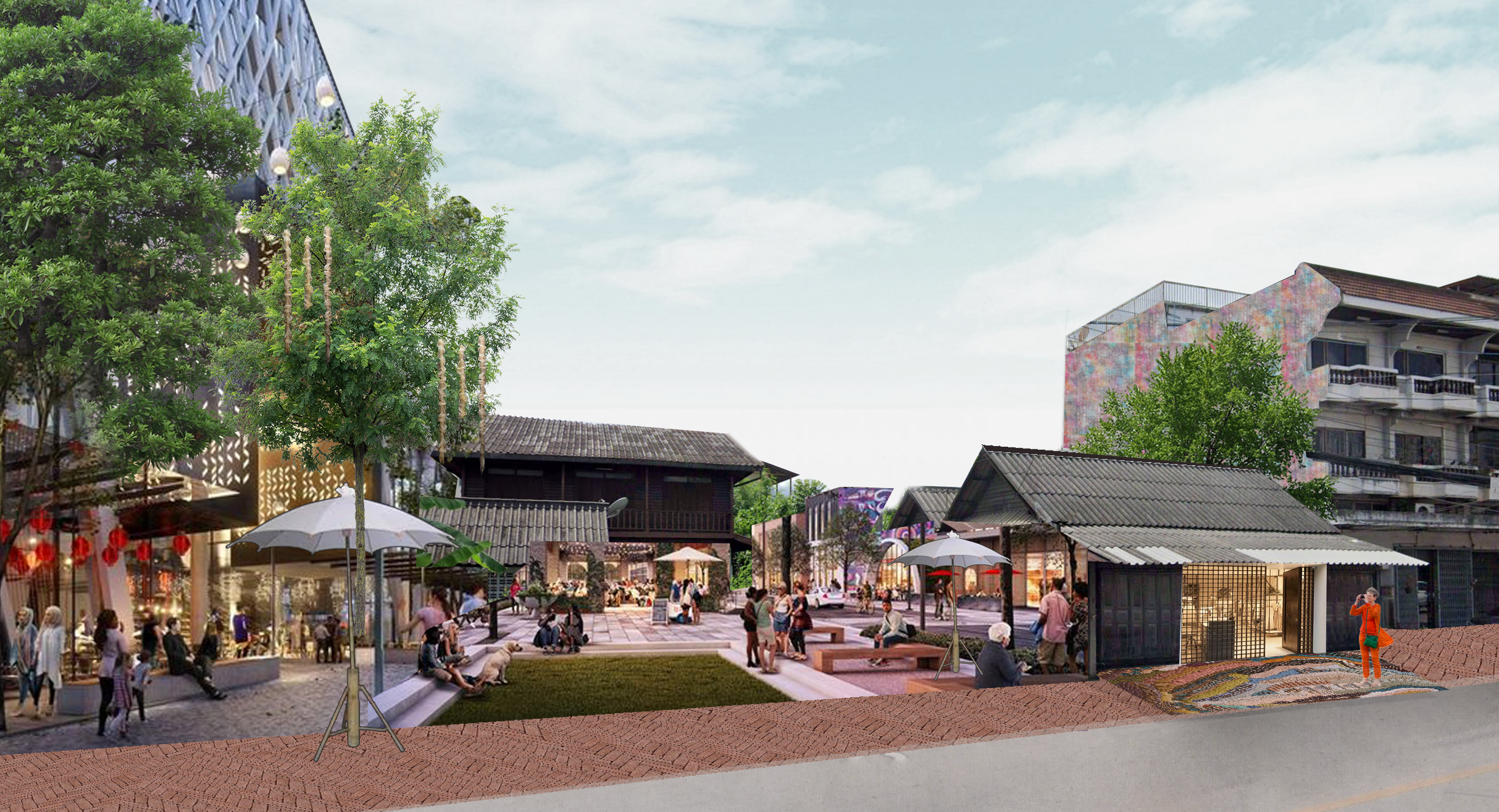
โครงการ
พัฒนาฟื้นฟูพื้นที่ต่อเนื่องคูเมือง-ริมน้ำปิงสู่ย่านหัตถนวัตกรรม เป็นโครงการที่มุ่งเน้นการพัฒนาย่านเศรษฐกิจใหม่ที่สามารถช่วยสร้างโอกาสในการพลิกฟื้นเศรษฐกิจของเมือง ผ่านการบูรณาการองค์ประกอบเมืองระหว่างบริบทเดิมที่มีคุณค่ากับสิ่งใหม่ที่สามารถสร้างอนาคตให้แก่เมือง โดยในปัจจุบันเมืองเชียงใหม่มีบทบาทสำคัญในระดับภูมิภาค และเป็นเมืองสร้างสรรค์ของไทยด้านหัตถกรรมและศิลปะพื้นบ้านที่เป็นที่รู้จักในระดับโลก แต่เมืองกลับติดกับดักทางเศรษฐกิจและขาดเสถียรภาพอยู่บ่อยครั้ง ซึ่งประเด็นสำคัญของเมืองเศรษฐกิจสองขาอย่างเมืองเชียงใหม่ที่มีทั้งขาเศรษฐกิจท้องถิ่นและเศรษฐกิจการท่องเที่ยว คือการพัฒนาให้เกิดความสมดุลโดยไม่ก่อให้เกิดการทำลายคุณค่าความเป็นชุมชน สังคม และสภาพแวดล้อมเมือง เพื่อคงความเป็นเอกลักษณ์ของพื้นที่อันเต็มไปด้วยเสน่ห์เฉพาะตัว ไม่ให้เลือนหายไปตามกระแสการพัฒนาใหม่ ดังนั้นการที่จะพัฒนาทั้งสองด้านไปพร้อมกันได้อย่างมีประสิทธิภาพจำเป็นต้องมีการสร้างย่านที่สามารถดึงดูดผู้คนที่หลากหลาย ก่อให้เกิดกิจกรรมที่มีความเข้มข้นสูงและมีความยืดหยุ่นในการใช้งาน
จากประเด็นปัญหาและสถานการณ์ข้างต้น จึงมีการวางกรอบแนวคิดในการศึกษาเพื่อแก้ไขปัญหาทางเศรษฐกิจไปพร้อมกับการพัฒนาคุณภาพการอยู่อาศัย ด้วยการสร้างย่านหัตถนวัตกรรม ผ่านการใช้เครื่องมือทางผังเมืองอย่างการปรับปรุงซ่อมแซมและการอนุรักษ์ โดยมีแนวคิด 4 ส่วนหลักได้แก่ Creative Economy/Creative City ที่เป็นรากฐานต้นทุนเดิมของเมือง Innovation District ที่จะมาช่วยต่อยอดการเป็นเมืองสร้างสรรค์ New Urbanism ที่จะช่วยส่งเสริมกิจกรรมบนถนน คืนความมีชีวิตชีวาให้แก่คนเมืองและ Image of the city ที่จะมาช่วยผลักดันการส่งเสริมภูมิทัศน์ของเมืองเก่าให้กลับมามีความหมาย มาบูรณาการร่วมกันเพื่อให้เกิดการดึงองค์ประกอบทางเศรษฐกิจ กายภาพ และการเชื่อมต่อมาสานกันเพื่อสร้าง Branding ใหม่ให้แก่เมือง
ปัจจุบันพื้นที่ภายในย่านยังไม่สามารถรองรับกิจกรรมการผลิตรูปแบบใหม่ได้เนื่องจากส่วนใหญ่เป็นตึกแถว อาคารพาณิชย์ขนาดเล็ก แต่ความต้องการใช้พื้นที่ของกิจกรรม และผู้คนต้องการพื้นที่ที่ขนาดใหญ่ขึ้น และมีความหลากหลายมากขึ้น การใส่กิจกรรมทางเศรษฐกิจใหม่ให้แก่ย่านจึงจำเป็นต้องศึกษาระบบที่มีความสอดคล้องกับกิจกรรมเดิมในพื้นที่ รวมถึงต้องเป็นกิจกรรมที่สามารถส่งผลกระทบทางเศรษฐกิจได้ในทิศทางที่ดีดังนั้นจึงมีการสร้างโมเดลธุรกิจ (Business Model) ของย่านหัตถนวัตกรรมให้เป็นด้านการผลิตวัสดุและสิ่งทอจากธรรมชาติที่ต่อยอดมาจากต้นทุนเดิมภายในพื้นที่ แบ่งเป็น 5 ขั้นตอน เริ่มจากการดึงความร่วมมือจากพื้นที่แหล่งผลิตภายนอกมาเป็นต้นทุน โดยโปรแกรมในพื้นที่จะเริ่มจากการสร้างจุดดึงดูดทางนวัตกรรมเพื่อนำไปสู่การดึงความร่วมมือจากคนในท้องถิ่นให้เกิดการแลกเปลี่ยนและเป็นส่วนหนึ่งของการผลิต จนนำไปสู่การผลักดันธุรกิจการค้าและการส่งออก
ซึ่งโครงการนี้สามารถตอบโจทย์ในเรื่องของการนำแนวคิดการพัฒนาย่านใหม่ภายในพื้นที่เมืองเก่าได้อย่างผสมผสานกลมกลืนกันระหว่างกลุ่มคน และกิจกรรม บนพื้นฐานศักยภาพเดิมของพื้นที่ที่รายล้อมไปด้วยทุนที่สามารถต่อยอดได้ โดยมุ่งเน้นการพัฒนา 3 องค์ประกอบสำคัญอันได้แก่
- การปรับเปลี่ยนประโยชน์ใช้สอยของอาคารเก่าที่อยู่ท่ามกลางพื้นที่ที่มีคุณค่า และมีศักยภาพการพัฒนาสูง ตามกลยุทธ์การพัฒนาฟื้นฟูอาคาร (Rehabilitation) 3 ขั้นตอนเริ่มจากการนำอาคารเก่ามาปรับเปลี่ยนพื้นที่ใช้สอย เช่น การต่อเติมชั้นอาคาร หลังอาคาร การรวมชั้นอาคาร และการลดทอนพื้นที่ แล้วจึงเพิ่มกิจกรรมให้เกิดการใช้งานอย่างเต็มประสิทธิภาพมากขึ้นไม่ว่าจะเป็นการเพิ่มการใช้งานแบบผสมผสาน การสร้างกิจกรรมระดับดิน ดาดฟ้า และการเปิดสู่พื้นที่ใช้งานหลังอาคาร เป็นต้น
- การพัฒนาพื้นที่ว่างหลังอาคารที่รกร้างไม่มีการใช้งาน ให้เป็นพื้นที่สาธารณะหรือใช้งานร่วมกันระหว่างผู้ใช้ในกลุ่มอาคารเดียวกัน เพื่อให้เกิดการใช้พื้นที่ในเมืองอย่างเกิดประโยชน์สูงสุด
- สร้างกิจกรรมให้แก่ถนนสายหลัก เพื่อทำให้เกิดการสร้างย่านที่มีชีวิตชีวา มีบรรยากาศที่เอื้อต่อการทำธุรกิจ และกระตุ้นให้เกิดความคิดสร้างสรรค์ และพัฒนาโครงข่ายการเดินสีเขียวในถนนสายรอง เพื่อสร้างความเชื่อมโยงไปยังพื้นที่โดยรอบ และสานต่อโครงข่ายในระดับเมือง
หากสามารถพัฒนากายภาพเมืองให้ครบทั้ง 3 องค์ประกอบได้จะทำให้เกิดการผลักดันการใช้พื้นที่ในเมืองได้อย่างเต็มประสิทธิภาพ อีกทั้งยังเอื้อประโยชน์ต่อเจ้าของอาคารในพื้นที่ให้มีโอกาสในการปล่อยเช่า และสร้างรายได้จากการนำอาคารไปหมุนเวียนเพื่อการลงทุนมากขึ้น ผู้เช่า และผู้ประกอบการ หรือกลุ่มนักลงทุนขนาดกลางและขนาดย่อมที่ต้องการเข้ามาเช่าพื้นที่ในเมือง ก็สามารถเช่าได้ในราคาที่ถูกลงเนื่องจากเป็นการแบ่งสัดส่วนพื้นที่ที่เหมาะสมกว่าการเช่าทั้งอาคารหรือซื้อทั้งอาคารที่ใช้งบประมาณในการลงทุนสูง โดยกระบวนการทั้งหมดจะถูกควบคุมภายใต้กลไกทางผังเมืองทั้งการวางกรอบแนวทางการอนุรักษ์และพัฒนา การกำหนดลักษณะการควบคุมทางกายภาพ (Overlay Control) รวมถึงการสร้างแนวทางการออกแบบให้แก่ย่าน (Design Guidelines)
สำหรับการพัฒนาย่านให้เป็นไปตามข้อเสนอที่ได้กล่าวไปในข้างต้น จำเป็นต้องเริ่มต้นจากการสร้างความร่วมมือในทุกภาคส่วนทั้งภาครัฐ เอกชน ชุมชน และองค์กรสถาบัน เพื่อให้เกิดการสร้างโอกาสในพลิกฟื้นเศรษฐกิจ ด้วยการสร้างย่านหัตถนวัตกรรมที่ต่อยอดจากรากฐานเดิมของเมือง ในการเป็นพื้นที่ธุรกิจการค้าเก่าแก่ที่เต็มไปด้วย องค์ความรู้ มรดกทางพื้นที่ บุคลากรที่มีความสามารถ ต้นทุนทางแหล่งผลิตด้านวัสดุและสิ่งทอที่มีชื่อเสียง ให้มีการทำงานร่วมกันได้อย่างเต็มประสิทธิภาพ เพื่อให้เกิดการสร้างย่านที่เป็นหัวใจสำคัญของการกระตุ้นเศรษฐกิจเมืองอย่างยั่งยืน
The Urban Revitalization of Chiang Mai Old Town is the project that emphasizes economic district development which can create opportunities and build an advantage to the economic situation. Through the integration of urban elements between the values of old contexts and new ones. Nowadays, Chiang Mai has an important role as the largest city in Northern Thailand and officially recognized as a Creative City of Craft and Folk art. The economic instability situation in Chiang Mai is one of the most important issues that highly dependent on tourism sector and the hardest part is how to drive the economy along with maintaining the uniqueness of the city. Therefore, the development of both important sectors: Local Economy and Tourism have to build a district core which has high concentration of activity, various of people, and flexible space.
A conceptual framework creating an innovative handicraft: Craft-Tech district through the use of urban planning tools such as urban rehabilitation and conservation, with four main concepts: First, Creative City/Creative Economy, which places creativity and cultural industries at the local level and actively cooperates at the international level. Second, The Innovation District, which facilitates the creation and commercialization of new ideas and also supports metropolitan economies by growing jobs in ways that leverage their distinct economic attributes. Third, New Urbanism, which will promote street activities and revitalize the city. Lastly, The Image of the city, which will encourage the old town landscape to be meaningful and will connect all of urban elements to become a new city branding.
At the present, the district is unable to support new types of manufacturing activities because most of the buildings are shophouses and small commercial buildings with low ceiling shopfront, whereas the demands of use need larger spaces and more diverse. Thus, to make a consistent with existing activities in the old area, new program must be an activity that able to create a positive effect to the economy. Accordingly, this study is aim to create a business model of an innovative handicraft: Craft-Tech district in the production of natural materials textures and textiles through a five-step process, starting from extracting cooperation from production area. In site programs will start with the creation of innovation attraction to bring cooperation and exchange the local knowledge with new innovative ideas.
This project brings the concept of developing a new district within the old city with a harmonious blend of people and activities based on the original potential of the area focusing on the development of 3 key elements:
- Densification of old buildings: creating high development potential according to the building rehabilitation development strategies: 3 steps, which starting from bringing the old building and adjust the usable area such as maximize building floors, consolidate floors and zoning to separate different type of use or ownership and reduce waste space by dividing a space for rent. Then, increasing the usage efficiently by holding interesting activities, whether it is adding a mix of use (Mixed use building), Creating ground-level activities, decks/roof activity, and connect space from front to back of building or areas.
- Developing empty spaces or abandoned spaces around buildings to become a public spaces or sharing places among users in the same building group in order to assemble people together and make a lively buzzing atmosphere.
- Creating activities on the main roads/streets to create a vibrant neighborhood which stimulates business atmosphere and creative environment. Last, developing a green-walking network in secondary roads or streets in order to connect the surrounding area and link to the city backbone.
If the physical of the city can be completely developed all of three elements mentioned above, it will drive the use of urban space to its fullest potential and also benefits the owners of buildings in the district to have the opportunity to rent out and generate income from turning the building into investment circulation. So, the tenants, entrepreneurs or small and medium-sized enterprises, who want to rent a space in the heart of city, can rent at a lower price and can have various choices: according to densification and rehabilitation strategies because they can afford a space that suited their purposes in the appropriate sizes and prices which is better than renting a whole building or buying a whole building with high cost of investment. All processes will be controlled under the city planning mechanism, including the framework for conservation and development by defining physical control characteristics (Overlay Control) as well as creating design guidelines for the district.
In conclusion, for the development of Craft-Tech district following by the proposals mentioned above, it is necessary to start from building cooperation in all sectors including the public, private, community and institutional organizations in order to create opportunities for economic recovery by creating an innovative handicraft district that builds on the city’s original roots in being an old commercial business area full of knowledges, local heritages, skills workers, and rich resources of producing materials textures and textiles to work together effectively and create a neighborhood that is the heart of sustainable urban economic stimulation.

